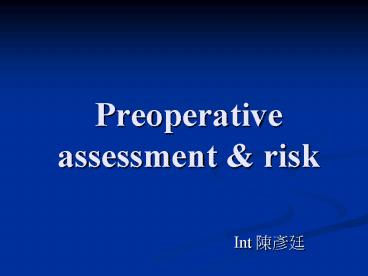Preoperative assessment - PowerPoint PPT Presentation
1 / 20
Title: Preoperative assessment
1
Preoperative assessment risk
- Int ???
2
Basic Data Chief complaint
- 85 y/o gentleman
- With an intertrochanteric femur
fractureScheduled to undergo surgery for the
placement of a dynamic hip screw
3
Brief history PE
- BP 190/120 mmHgUnknown antihypertensive
medication used daily - Resting pulse rate 140/minRadial pulse is
irregular in tempo and volume - Systolic murmur over apex, Gr 3
- Ankle edema
- Bilateral basal crepitation in the lungsCant
lie flat (orthopnea) - Hematocrit 31
4
Question 1
- What is your preliminary diagnosis regarding the
cardiovascular system of the patient?
5
- BP 190/120 mmHg? history of hypertension with
unknown antihypertensive medication used daily - Resting pulse rate 140/minRadial pulse is
irregular in tempo and volume?tachycardia with
arrhythmia - Systolic murmur over apex, Gr 3?suspect MR
6
- Ankle edema ? may related to Rt heart
failure, malnutrition, liver or renal disease - Bilateral basal crepitation in the lungsCant
lie flat (orthopnea)?may be pulmonary edema due
to Lt heart failure or MR - Hematocrit 31
- ?anemia, maybe due to chronic malnutrition,
chronic renal impairment or bleeding
7
- HTN
- Heart function
- Liver function
- Renal function
- anemia
8
Question
- What preoperative management will you recommend
to optimize the patient?
9
- Pre-op evaluation
- CBC\DC, electrolyte, albumin, liver enzyme
(GOT\GPT), BUN\Cr, PT\aPTT - EKG
- CXR
- Cardiac echo
- Stool OB test
10
Hypertension
- Determinants of risk
- Level of blood pressure.
- Duration of treatment.
- Degree of end organ damage. (LVH, CRF, CVA,
CAD, LVF) - Type of surgery.
11
- Level of blood pressure.
- Asymptomatic patients with mild to moderate HTN
(DBPlt110 mmHg) are not at increased risk. - Elective surgery should be postponed in the case
of DBPgt110 mmHg complications, DBPgt120 mmHg
without. - Isolated systolic HTN lt200 mmHg should not defer
surgery unless for vascular surgery or
craniotomies (increased risk).
12
- Duration of treatment
- Continue all antihypertensives up to and
including the day of surgery (except diuretics). - Delay elective surgery if SBPgt200 mmHg, or if DBP
gt120 mmHg, until BP lt190/110 mmHg, preferably
lowered to 140/90 mmHg over several weeks. - Acute control within hours of surgery is
inadvisable.
13
- Type of surgery associated with increased risk
- Aortic surgery,
- carotid endarterectomy,
- CABG,
- craniotomies (aneurysm clipping),
- AVM,
- posterior fossa surgery.
14
Heart failure
- Preoperative evaluation
- echocardiography
- radionuclide angiography
- Brain Natriuretic Peptide (BNP)
15
- An ejection fraction less than 40 predicts
adverse cardiac outcome. - In some patients coronary bypass surgery or
coronary angioplasty and stenting improve left
ventricular function to such an extent that even
major surgery becomes considerably safer. - An increasing number of patients with heart
failure are now receiving beta-blockers. The
latter improve their long-term prognosis,
especially where carvedilol is used.
16
Question
- 3. Which anesthetic technique will you use? Why?
17
Antihypertensive therapy
- Use of agents to attenuate the haemodynamic
responses to intubation, incision and extubation - Opioids Fentanyl, Alfentanyl.
- Antihypertensives Esmolol, Labetalol, Atenolol,
Metoprolol, clonidine, enalapril (one dose
preop). - Lidocaine
18
Hydration
- Volume load the hypertensive patient prior to
induction. - ?This helps to minimise the peaks and valleys
that characterise the hypertensive patient.
19
Choice of agents
- Consider using agents with minimal haemodynamic
effects - Fentanyl with thiopentone rather than propofol
- pethidine rather than morphine,
- vecuronium or cis-atracurium rather than
atracurium, sevoflurane induction etc.
20
Analgesia
- Opioid and non steroidal anti-inflammatory agents
prevent the hypertensive response to pain, intra-
and post- operatively

